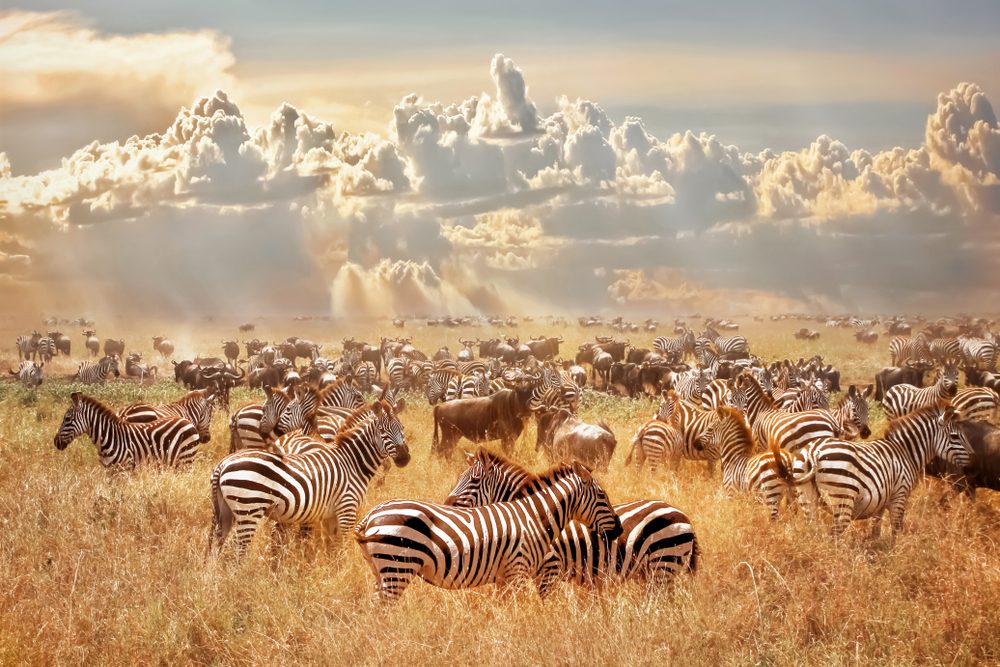
Serengeti National park
The Serengeti National Park is a large national park in northern Tanzania that stretches over 14,763 km2 (5,700 sq mi). It is located entirely in the eastern Mara Region and northeast portion of the Simiyu Region. It also contains over 15,000,000 hectares (37,000,000 acres) of virgin savanna.
The Serengeti is well known for the largest annual animal migration in the world. This is of over 1.5 million blue wildebeest and 250,000 zebra and the largest lion population in Africa. It is under threat from deforestation, population growth, and ranching.
Maasai people called this park ‘Siringet’, meaning endless plains. The Serengeti speaks for itself. Not only is the migration of over 1 million wildebeest through its plains and woodlands but also unique landscapes and other spectacular wildlife.
The Serengeti is home to the world’s largest populations of Wildebeest, Zebra, Cape Eland, Lion, Cheetah, Hyena, and Gazelles. The scenic beauty of the sky with cool nights and warm days makes your visit to this remaining home for the great migration of large mammals incredible!
Climate
The climate of the Serengeti National Park is subtropical. A rainy season from November to April and a dry season from May to October.
The park is located at an altitude between 1,100 and 2,000 meters with annual average rainfall ranging from 900 to 1,000 mm.
Getting there
The park can be accessed by road and air.
By road: Accessed from all towns and cities to the present entry or exit points/gates. Thes are Naabi Hill, Seronera, Ndutu, Kusini, Kirawira, Handajega, Ikoma, Tabora ‘B’, Lamai, Lobo, Ndabaka, Machochwe, and Kleins.
By air: There are all-weather airstrips in the center of the park (Seronera), in the South (Kusini), in the East (Lobo), in the West (Kirawira), and in the North (Kogatende & Lamai). There are scheduled and private charters from Arusha, Mwanza, Kilimanjaro, Musoma, Dar es Salaam and also Zanzibar.
Attractions
Serengeti National Park, is a world-renown, World Biosphere Reserve and World Heritage Site that has many more attractions than any other national park in Africa. The Great Migration, The Big Five, Unique Bird Collections, Endangered Species. Also, there is the highest concentration of Carnivores and Herbivores. There are also Scenic and also Spectacular Landscapes are some of the attractions one will encounter!
Diverse Birdlife
With more than 530 species recorded quarter being those migrating from other parts of the world. The park forms an ecological important bird area and an ideal place for bird lovers. Some of the species commonly seen are European and also Abdim’s storks, Eurasian Roller, Barn Swallows, Fish & Martial Eagles, etc.
Cultural & Historical Sites
Serengeti is home to many cultures from the famous tribes of Maasai, Sukuma, Kurya, and Ikoma. Indigenous Maasai and Ikoma use to live in parts of the park before they were made to settle outside the park. The present signs are still visible in famous Maasai Rock paintings. Also, they are at Gong rock, and Ikoma ruin marks a special combination of game viewing and human history.
Scenic and Spectacular Landscapes
The vast scenic and unspoiled landscapes among others made this area recognized as a World Heritage Site by UNESCO. Its vast plains, rolling hills, and the island of Kopjes increases the beauty of the park
Plants and Insects
The park is rich in plant life as well as insects. During the rainy seasons the park bust in wildflowers and beautiful butterflies providing an exceptional experience for botanists and also entomologists.
Activities
Having unparalleled attractions, Serengeti has a number of tourism activities and opportunities for visitors to get the best wildlife experience! Some of these include Hot Air balloons, Game viewing, Filming and photographic safaris. There are also Walking safaris, Bush meals, and Cultural tourism






